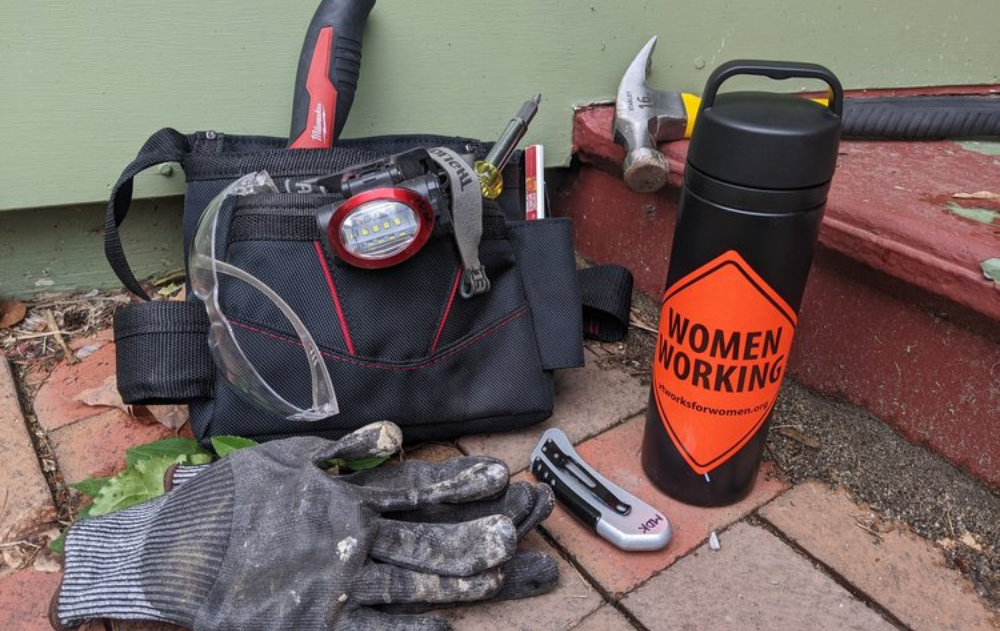A Writer Joins a Weatherization Crew

This story was originally published by 350vt.org. Author Marisa Keller graduated from VWW’s first Trailblazers: Green trades training program in construction and renewable energy. Thanks to Marisa for sharing her experience joining a weatherization crew during her Trailblazers: Green internship.
By: Marisa Keller, Trailblazers Graduate
Since I showed up to a 350Vermont meeting six years ago and said, “I’m a writer; what can I do?” most of my climate justice work has revolved around words—composing letters to the editor, writing emails, editing zines, and exhorting various changemakers to reject greenwashing and create real solutions. So it came as something of a surprise this summer when I said to myself suddenly, You know, it’s all very well to demand funding for low-income weatherization, but someone needs to go out there and actually do it—and why not me?
There are so many ways to work for climate justice, and 350VT often uses Spirit in Action’s framework of the 4Rs of social change—Resist, Reform, Reimagine, and Recreate—to help people recognize the possibilities and find the justice work that suits them best. The kind of communications I’ve been drawn to falls mostly in the realms of Resist and Reimagine—raising awareness about false solutions and dreaming up new possibilities. Hands-on services like weatherization fall into the Reform and Recreate categories—meeting people’s needs in our current reality and building resilience for the future.

I signed up for a green trades training course through Vermont Works for Women, and as part of that program spent three weeks interning on a weatherization crew with Capstone Community Action, out of Barre, which serves low-income folks across central Vermont. I was the only woman on a crew of guys, most of them from very different backgrounds than mine, with very different interests. But we had the work in common, and they were good teachers and coworkers, who explained to me what I needed to know and then let me do it, without a hint of condescension.
I installed weatherstripping with a nail gun; I sealed cracks and holes with caulk and spray foam; I loaded bales of cellulose into the insulation-blowing machine and wielded the hose that packed it into roof slopes and ceilings; I wired a bathroom fan; I spent a morning on my back underneath a trailer using all my strength to drive screws through strapping and old saggy fiberglass insulation into the floor joists above me. I loved the work.
But from the very first day, they warned me: the hardest part of this job is seeing how people live. I found out for myself soon enough. It’s one thing to know that people live in ramshackle houses and run-down trailers, or to maybe see them as you drive by; it’s another thing entirely to traipse through people’s living rooms and crawl through their basements and squeeze into their attics. I went home every day with the smell of inequity clinging to my clothes, the weight of injustice in my bones.
For a while during the second week, I didn’t think I could handle the work long-term: I still enjoyed myself while I was working, but at night anxiety-adrenaline filled my stomach and I had trouble sleeping. The rest of my life, all the possibilities and enjoyments and satisfactions that make the days rich, felt unreachable. Why should I get to have anything that others lack? But how could I survive without?
Then one day I walked the five miles home after work, a two-hour journey along the railroad tracks by the river on a beautiful fall evening, and I felt as though I had reclaimed my life and my right to have it, complicated privilege and all.
I learned, after that, to focus on the work, on the service we provided, and avoid imagining how I would feel if I lived in those houses. And I sure hope those strategies will keep working for me because I’ve now accepted a part-time position on the crew. I don’t ever plan to stop writing and reimagining, but I’ve found a home in Reform/Recreate now, too, with a caulk gun in my hands as well as a pen.
I’m still thinking through what kind of support I will need to sustain myself in this job, because working face-to-face with inequality is no joke, and doing it as the first woman on a crew of guys, no matter how enlightened, will be its own journey. But I want to be able to stick around, to keep making people’s homes more comfortable, their bills lower. I want to be living proof that you don’t have to be a bro with lots of construction experience in order to do this job. I want to put not just my words but my body into service. And that means learning how to care for myself—with the help of my friends and family and this whole wider network of all of you who are also doing this work—in a whole new way. Because justice is never just about what we do—it’s about how we treat ourselves and each other while we do it.
Which R represents most of the justice work you have done or are doing? Which R is calling to you right now? What support do you need in order to keep showing up for change?